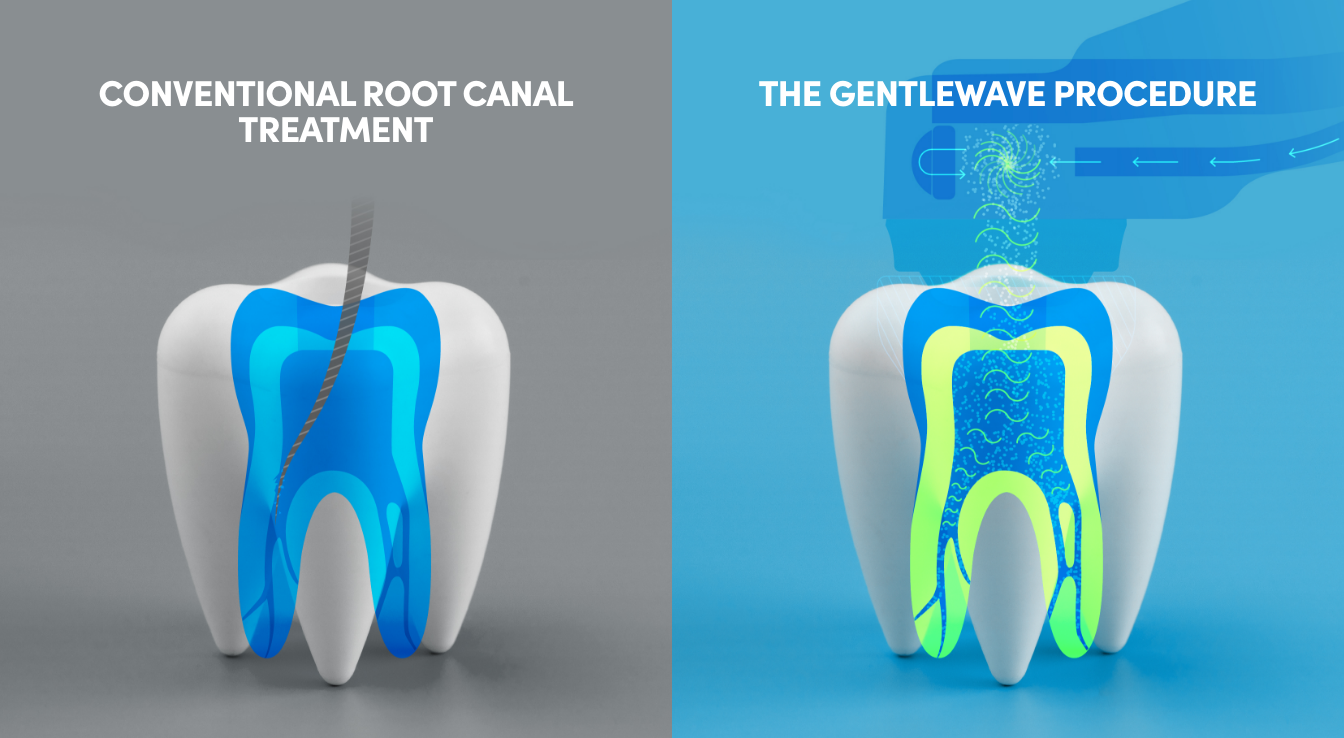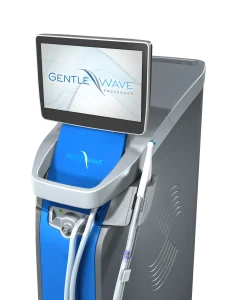
GentleWave offered at Sacramento Holistic Dentistry is the better root canal option.
Is There a Better Root Canal Option?
We hope you never have to make a decision between losing a tooth or seeking treatment to keep the tooth. We also understand that this is a sensitive topic and many people have strong beliefs one way or the other, and we believe that people should have the right to know their options, along with risks and benefits, and to make a choice that they feel is right for them. With that said, this blog will cover a relatively new development in the world of root canals for those people who would like to keep the shell of their tooth and are seeking a better alternative to a standard root canal.
The mere mention of a root canal can send shivers down the spine of even the most stoic patient. Traditionally, the root canal procedure has been associated with pain, discomfort, multiple visits to the dentist, and perhaps more importantly with issues of dead tissue being left in the tooth because it is impossible to clean lateral canals with root canal files, which leads to chronic low grade infections that may have an effect on health. However, with the advent of the GentleWave system, the practice of endodontics — the treatment of the interior of the tooth, including the root canal system — has undergone a quiet revolution.
If all dead nerve tissue is removed and just the mineral structure remains, then is the tooth truly dead? Some would say yes, while others would say that as long as all dead tissue has been removed then a mineral shell of a tooth is similar to an implant. Is an implant dead? I guess it can’t be dead because it was never alive, but in both cases an implant and a thoroughly cleaned tooth are not alive. If we set aside the secondary concerns that have to do with the electric system within our bodies, and focus on doing the best with an unfortunate situation of a tooth that needs either an extraction or the dead nerve removed, the GentleWave system, introduced in recent years, has transformed the way we think about and perform root canal therapy. GentleWave employs advanced fluid dynamics and broad-spectrum acoustic energy. This cutting-edge technology ensures better cleaning of the entire root canal system with precision and efficiency, minimizing the necessity for multiple appointments and improving patient comfort.
In this comprehensive examination of the GentleWave root canal procedure, we’ll explore the benefits of this cutting-edge technology over traditional root canal treatments and address common questions and misconceptions.
The Anatomy of a Root Canal
Before we unravel the benefits of GentleWave technology, it’s essential to understand the traditional root canal procedure and why advancements are needed. The root canal system is a complex network of chambers and canals within the interior of the tooth, housing the dental pulp, which consists of nerves, blood vessels, and other tissues. When the pulp becomes infected or inflamed, often due to deep decay, fractures, or trauma, a root canal procedure is necessary to remove the diseased pulp, clean the canals, and seal the space to prevent further infection.
For decades, the standard protocol for root canal therapy involved the use of thin files to manually shape and clean the canals, followed by irrigation with various disinfecting solutions. The limitations of this method included the potential for missed canals, incomplete cleaning, and the inability to effectively reach all areas of the root canal system, leaving dead nerve tissue in the tooth that could get re-infected and the body would either chronically fight the low grade infection from outside of the tooth (because no blood supply can get into the inside of the tooth once the nerve has died or been removed), or an acute re-infection would cause swelling and pain.
The picture below shows an illustration of lateral nerve canals that branch out … these lateral canals cannot be cleaned with files, but they can be cleaned with GentleWave.

The GentleWave Difference
The GentleWave system, developed by Sonendo® and cleared by the U.S. Food and Drug Administration (FDA) in 2015, stands apart with its ability to reach and clean even the most intricate areas of the root canal system. The distinct patented technology uses a combination of fluid dynamics and broad-spectrum sound to deliver a powerful yet delicate cleaning solution. The procedure starts by inserting the system’s handpiece into the prepared root canal space. Then, using a series of advanced multi-sonic fluid delivery protocols, the GentleWave system creates a vortex capable of reaching and cleaning microscopic spaces throughout the root canal system.
The technique disrupts the traditional reliance on files with its primary reliance on sound waves, which are catered to carry disinfecting solutions deep within the tooth. The result is an exhaustive root canal treatment with minimized trauma to the tooth structure and less time-consuming than traditional methods.

Benefits of the GentleWave System
Enhanced Cleaning and Debridement
The technology behind the GentleWave system’s fluid dynamics is nothing short of groundbreaking. By generating a cleansing solution into a vortex that reaches the entire root canal system, even into the lateral canals, it effectively removes debris and tissue remnants from minute anatomical structures. The broad-spectrum acoustic energy helps the fluids access and clean all parts of the canal, no matter how complex the structure — meaning cleaner canals and less chance of infection recurrence.
Preservation of Tooth Structure
One of the most significant benefits of the GentleWave system is its capacity to achieve a thorough cleaning of the root canal system with minimal reliance on the physical stress applied to the tooth structure. This reduced reliance on files means less chance of damage to the tooth and better preservation of the root’s integrity.
Efficiency and Convenience
More traditional root canal treatments require several visits for completion, with weeks of waiting between sessions to allow for the healing of tissues. In contrast, the GentleWave system often allows for the entire procedure to be completed in one visit. This not only reduces the overall treatment time but also ensures a more efficient process.
Comfort for the Patient
Numerous studies and patient testimonials highlight the significant reduction in postoperative pain and discomfort associated with the GentleWave procedure. The gentle nature of the sonic waves used in the cleaning process translates to a more comfortable experience for the individual undergoing the root canal.
Separating Fact from Fiction
Despite the clear advantages of the GentleWave system, there are common misconceptions that warrant dispelling. Here are a few:
The Myth of Extended Treatment Length
Some may assume that the complexity of the GentleWave procedure translates to longer, drawn-out treatments. However, many patients find that the opposite is true. The system’s efficiency often leads to shorter chair time, and despite the more intricate cleaning process, the associated procedures can often be completed in just one visit.
The Notion of Consistent Clinical Outcomes
No treatment is one-size-fits-all. The accuracy and precision of the GentleWave system, combined with the skill of the endodontist, generally lead to positive outcomes. Yet, there can be instances where there can be something else wrong with a tooth such as a root fracture, or simply not enough healthy tooth structure remaining for a permanent restoration.
The Idea that it’s a Standalone Solution
While the GentleWave system is a significant leap in the evolution of endodontic technology, it is not a standalone treatment for every root canal case. There are certain scenarios where the tooth is so broken down that it is not possible to attach the GentleWave to the tooth.
The Future of Endodontics
The introduction of the GentleWave system marks the next step in the ongoing evolution of endodontic technology. Its benefits in terms of efficiency, comfort, and thoroughness, when compared to traditional methods, are undeniable. The continuous refinement and advancement of such technologies will likely play a vital role in shifting the paradigm of root canal therapy.
For patients, the availability of state-of-the-art endodontic techniques like GentleWave ensures that dental care is continually improving, with a commitment to delivering the best possible outcomes. While the procedure might seem like a minor detail in the grand scheme of dental health, a truly clean root canal can make all the difference in achieving long-term dental wellness.
The featured image in this blog was from the GentleWave website. It shows the difference between the root canal treatment that is done with files (which leaves dead nerve tissues in accessory canals) and the GentleWave root canal option which sends waves and a vortex into the tooth in order to lift up the dead nerve tissue in accessory canals. If you have any questions about the GentleWave procedure, the GentleWave website has a number of educational blogs. We hope you don’t have to make a decision between losing a tooth and the GentleWave treatment, but if you do, we believe you should be able to make an informed decision and have access to the treatment that you prefer – whether that’s an extraction or GentleWave RCT.

